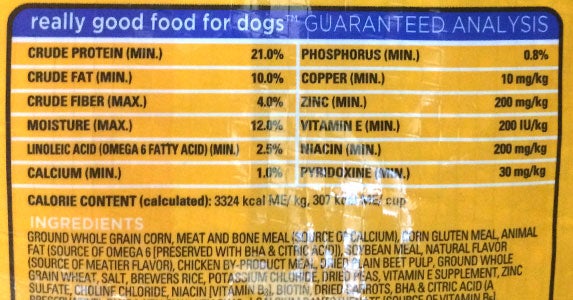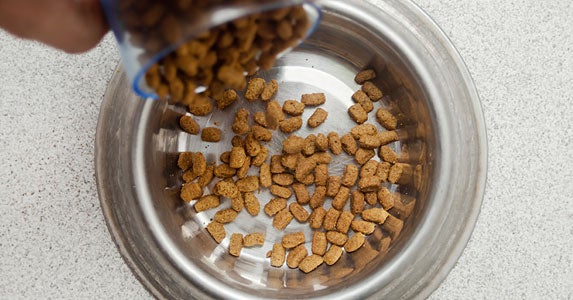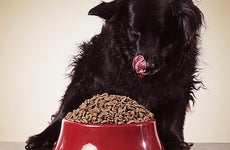How To Save Money When Buying Dog Food

The Bankrate promise
At Bankrate we strive to help you make smarter financial decisions. While we adhere to strict , this post may contain references to products from our partners. Here's an explanation for .
Confessions of a cheapskate dog owner

With my first dog, the best brindle boxer who ever lived, I bought the most expensive food I could afford — usually Purina One.
But a lot has changed since Brutus passed away — we have now 3 daughters. When you’re on a budget that’s stretched buying food for a family of 5, that giant bag of cheap food lurking on the bottom shelf looks tempting.
Vader, our black and white mutt with a heart of gold, seems healthy and happy, but I sometimes worry that by buying cheaper food, I’m endangering his health — and racking up significant vet bills down the road — just to save a few bucks.
However, there’s more to dog food than price, and price and quality don’t always go paw in paw, says Dr. Valerie Parker, DVM, an assistant professor — clinical, at The Ohio State University’s College of Veterinary Medicine.
“Paying more for pet food absolutely does not guarantee that it is, in any way, a better quality pet food,” says Parker.
In fact, pricey “gourmet” dog foods can easily contain less of the nutrients a dog needs than cheaper, mass-market foods, Parker says.
Confusing, right? Vague labeling, industry doublespeak and the complexities of pet nutrition can make deciding what to feed your dog a little hairy. Here’s what to know.
Saving money buying cheaper dog food

To get a sense of the amount of money at stake here, I ran the numbers. To simplify things, I focused on the period since Vader became an adult dog, because that’s when his nutritional needs stabilized at around 6 cups a day. (That’s a lot for his size, but with 3 little girls to keep entertained, he’s a very active dog.)
Since then, we’ve fed him almost exclusively Pedigree Adult Complete Nutrition, purchased in 50-pound bags from Costco to drive down the price even more.
One argument made in favor of buying more expensive food is that your dog can eat smaller quantities than it would have of the cheaper food and still stay healthy. To make sure I accounted for that, I used the calories per cup of each of the fancier foods to adjust the amount Vader would need.
Still, the savings from feeding the cheaper food is substantial. So far this year I’ve saved $146 passing on Purina One and a whopping $446 over the even fancier Blue Buffalo food. Over the course of Vader’s remaining lifetime (the average life span for dogs his size is 11 years), I’ll save a whopping $2,115.82 versus Purina One, and $6,467.16 versus Blue Buffalo.
Cheap dog food can be OK

For a healthy, young dog with no specific health problems or allergies, even buying the cheapest food at the store is probably OK, says Dr. Heather Loenser, DVM, veterinary adviser for professional and public affairs at the American Animal Hospital Association.
“I would say the biggest thing is making sure that it is something that your veterinarian is comfortable with your animal eating,” Loenser says.
Some dogs with certain allergies or health issues may need food with specific ingredients and nutritional content. In that case, it makes sense to buy special food for your dog that may be pricier to avoid more health problems down the road.
And don’t believe the hype from dog food companies and retailers about what your dog needs, Parker says.
“When there are questions about dog nutrition, it’s really in the client’s and pet’s best interest to speak to a veterinarian, or more specifically, a board-certified veterinarian nutritionist, rather than the employee at the pet store,” says Parker.
Here are some other ways to judge good food from bad.
Read the label

AAFCO stands for the Association of American Feed Control Officials, an organization that puts together nutritional standards for dog food. By law, food that’s designed to be the main source of nutrition for a dog has to have a statement to that effect on the bag, commonly known as the “AAFCO statement.”
Located under the guaranteed analysis and the ingredient list, the statement typically reads something like “(Dog food brand) is formulated to meet the nutrition levels established by the AAFCO Dog Food Nutrient Profiles for adult maintenance.”
Besides “for maintenance,” which translates to “for keeping an adult dog at a healthy weight,” another profile for “growth and reproduction” means food that’s good for puppies and female dogs that are nursing pups. You also may see the words “complete and balanced,” which means your pet can get all the nutrients it needs by eating that food.
Ultimately, the Food and Drug Administration is responsible for making sure the food is safe and meets the standards set by AAFCO.
Look at the calorie content

Measuring the price per 100 calories can be the best way to judge the value you’re getting in a pet food, Parker says.
Unfortunately, many foods don’t list calories per pound or kilogram, making it difficult to calculate how many calories are in a bag of food. It would be nice if dog food manufacturers had to put something such as “servings per container,” similar to human nutrition labels, but they don’t. (Call your senators!)
On the other hand, most American pets with reasonably caring owners aren’t suffering from a calorie deficit. In fact, it’s the other way around.
“We’re not seeing an epidemic of malnutrition from poorly manufactured dog food,” Loenser says. “We have an epidemic of obesity.”
More than half of the pets in the U.S. are overweight, which can lead to a host of uncomfortable and expensive-to-treat health issues, she says.
What doesn’t matter
| Type of dog food | YTD cost | 10-year cost |
|---|---|---|
| Pedigree Adult Complete Nutrition | $159.40 | $2,246.42 |
| Purina One Chicken and Rice | $305.30 | $4,302.53 |
| Blue Buffalo Life Protection Formula: Chicken and Brown Rice Recipe | $605.36 | $8,531.07 |
| Savings vs. Purina One | $145.90 | $2,056.11 |
| Savings vs. Blue Buffalo | $445.95 | $6,285.65 |
Buzzwords
You’ll often see words like “grain-free,” “holistic” and “all-natural,” which have either no real definition or are loosely defined, Parker says. A buzzword that does mean something: “organic,” which has a specific definition under the law.
Order of the ingredients
The ingredients’ order does not provide concrete information on how your dog will do on that food.
“There’s this myth out there that if the first ingredient isn’t meat, it’s a bad food,” Parker says.
Because ingredients in dog food are ordered by weight, the truth is more complicated than that. For instance, a manufacturer may boast using fresh meat. But most of the weight in fresh meat is water, so a food with meat as the first ingredient may actually contain less animal protein than a food that uses dried meat.
Guaranteed analysis
The guaranteed analysis can be manipulated, making it difficult for consumers to draw specific conclusions.
“The guaranteed analysis unfortunately is not very useful,” Parker says. “There are just a few selected nutrients given in minimums or maximums that don’t necessarily have to correlate with the actual, typical nutrient analysis,” Parker says. “It doesn’t allow owners to compare one food to another by looking at the guaranteed analysis percents.”
Bottom line: We dog owners love our pets and want what’s best for them, whether it saves a few bucks or not, so take this news with a grain of … kibble.
Related Articles



